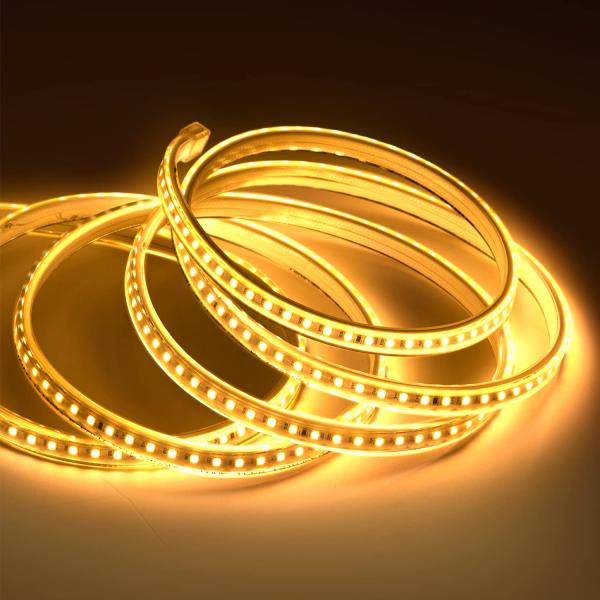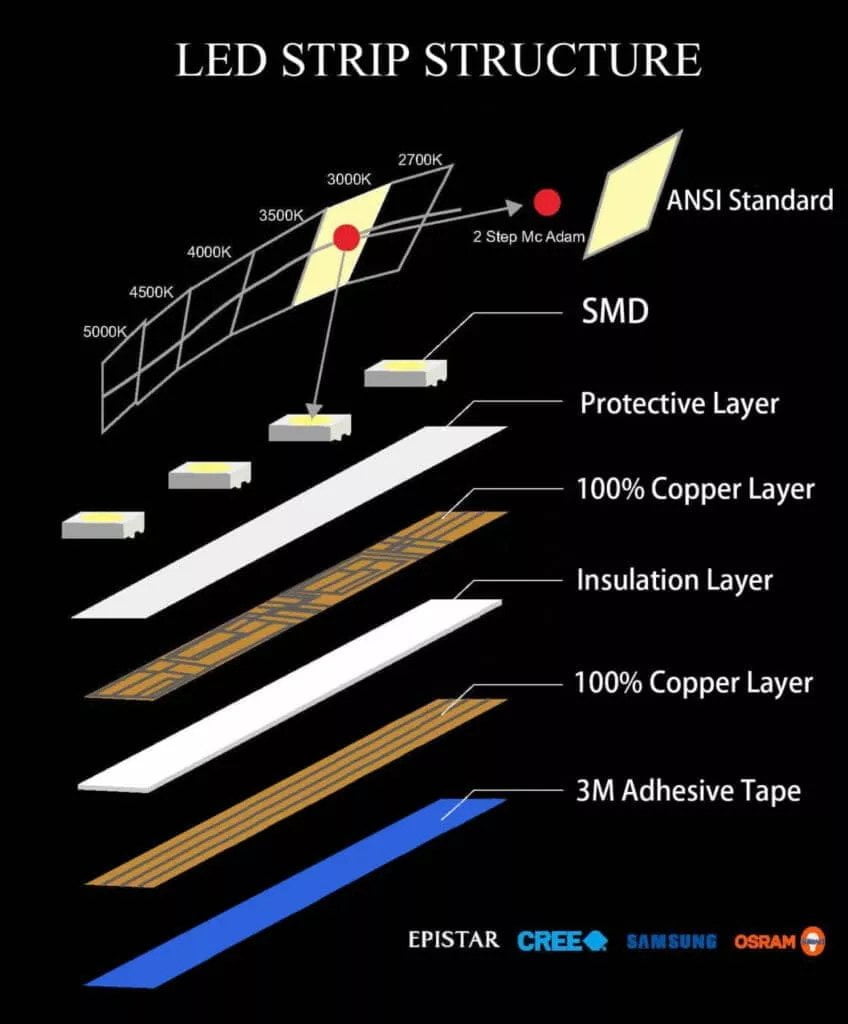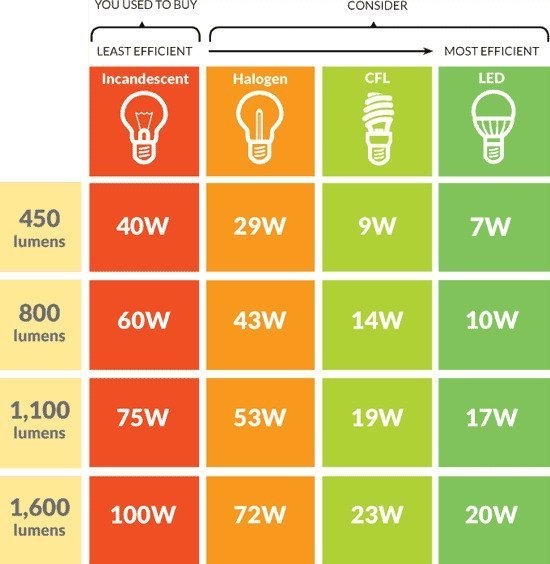Do LED Strip Lights Consume High Electricity?
Table of Contents
LED strips have gained popularity and are a superb option for illuminating commercial, residential, and industrial settings. They offer efficiency, simple installation, and low maintenance requirements. You can customize their shape and size with LED strips, making them suitable for lighting virtually any space.
The fundamental elements of LED strips consist of SMD LEDs, FPCB (Flexible Printed Circuit Boards), and additional components like resistors. Using the Surface Mount Technology (SMT) Assembly Process, LEDs, resistors, and other components are mounted onto the FPCB while manufacturing LED strips.

The Basics of LED Functionality
An LED, or light-emitting diode, is a semiconductor device that emits light when an electric current passes through it. When electrons within the semiconductor recombine with electron holes, they release energy as photons. The colour of the emitted light is determined by the energy required for electrons to traverse the band gap of the semiconductor material. To achieve white light, multiple semiconductors or a layer of light-emitting phosphor are utilized alongside the semiconductor component.

Energy Efficiency of LEDs vs. Traditional Lighting
LEDs are known for their energy efficiency and minimal heat generation. They are illuminated solely by the movement of electrons in a semiconductor material. Moreover, their lifespan is comparable to that of a standard transistor, exceeding 50,000 hours. LEDs offer numerous advantages over traditional incandescent lamps, with their primary benefit being efficiency.
In incandescent lamps, light production generates a substantial amount of heat, as the filament must be heated to produce illumination. Unless the intention is to utilize the incandescent lamp as a heat source, this excess heat represents wasted energy, as a significant portion of the supplied electricity is not utilized to generate visible light. In contrast, LEDs generate minimal heat. A higher percentage of the electrical energy is directly converted into light, significantly reducing overall electrical demand.
Understanding the Inner Workings of an LED
An LED, or Light Emitting Diode, is a semiconductor device that converts electrical energy into light. It operates based on electroluminescence, wherein light is emitted when electrons and holes recombine within the semiconductor material. When a voltage is applied to the LED, electrons are injected from the negative terminal (cathode) into the semiconductor material, while holes are injected from the positive terminal (anode).
As the electrons and holes meet, energy is released as photons, resulting in light emission. The colour of the emitted light depends on the specific materials used in the LED’s construction. LEDs are known for their energy efficiency, durability, and versatility, making them widely used in various applications such as lighting, displays, and indicators.
How does incandescent lighting work?
Compared to regular incandescent lamps, LEDs generate more lumens (the measure of visible light) per watt. Light-emitting diodes possess superior luminous efficiency, converting electricity into visible light more effectively than incandescent lamps. While a 60-watt incandescent lamp can produce 750-900 lumens, an LED bulb using only 6-8 watts can provide an equivalent brightness level.

Calculating the Power Consumption of an LED Strip: A Step-by-Step Guide
To determine the power consumption of an LED strip, you must consider the power per meter of the strip and the length of the strip being used.
LED strips are commonly available in various power ratings such as 2.4W/m (0.73W/foot), 4.8W/m (1.46W/foot), 7.2W/m (2.19W/foot), 9.6W/m (2.93W/foot), 14.4W/m (4.39W/foot), 19.2W/m (5.85W/foot), 24W/m (7.32W/foot), and so on.
For instance, let’s consider a scenario where a 5m LED strip with a power rating of 14.4W/m (1.46W/foot) operates 12 hours a day, 365 days a year. In this case, you can calculate the total electricity consumption for the year as follows:
Power Consumption = Power per meter × Length of strip × Daily usage time × Number of days in a year Power Consumption = 14.4W/m × 5m × 12 hours/day × 365 days/year = 315,360 kW·h
In summary,
LED strips exhibit exceptional energy efficiency, consuming significantly less electricity than incandescent, halogen, and fluorescent lamps. At MyliKeLed, we craft superior LED strips and LED neon flex, renowned for their remarkable quality. Our products undergo rigorous testing in state-of-the-art laboratories to guarantee unparalleled performance.
Moreover, we provide tailored customization options for our LED strips and neon flex, catering to your needs. Don’t hesitate to contact MyliKeLed right away for top-notch LED strip and LED neon flex solutions.
FAQs
LED strip lights typically use between 4 to 20 watts per meter. The exact usage depends on the type, brightness, and color of the strip.
No, using LED strip lights is unlikely to significantly increase your electricity bill. Their low wattage means they consume minimal energy even if left on for long periods.
Yes, LED strip lights are much more efficient than traditional incandescent or fluorescent lights. They produce more light using less energy, which saves you money over time.
You can calculate it by multiplying the wattage of your LED strip by the hours it’s used daily, then dividing by 1,000 to get kilowatt-hours (kWh), and finally multiplying by your local electricity rate.
Yes, it is okay to leave LED strip lights on all night. Because they use very little electricity and generate low heat, they are safe for extended use.

Hi, I’m Xylia Xiong, a sales professional with 14 years of experience in the LED strip light industry. I specialize in providing tailored solutions, leveraging my expertise in LED products and the latest industry trends. Known for effective communication and problem-solving, I’m dedicated to helping lighting manufacturers, importers, and distributors achieve their goals.
Let’s work together to create customized solutions that exceed expectations.
Related Posts

The Best LED Strip Lights You Can Buy Right Now

Comparing WS2811 Vs WS2812B: Key Differences


